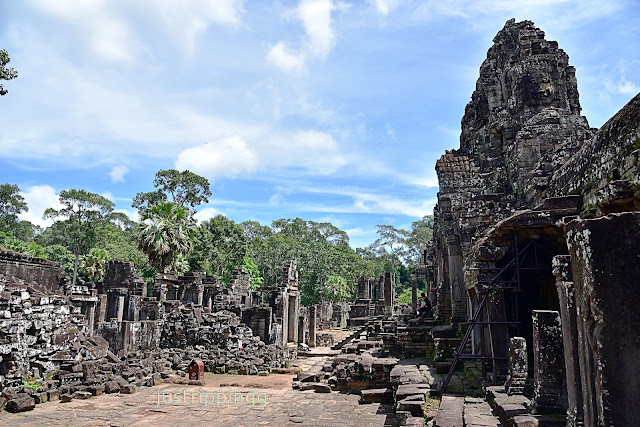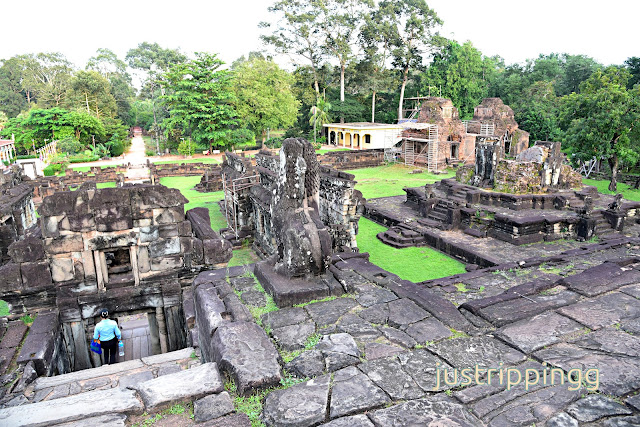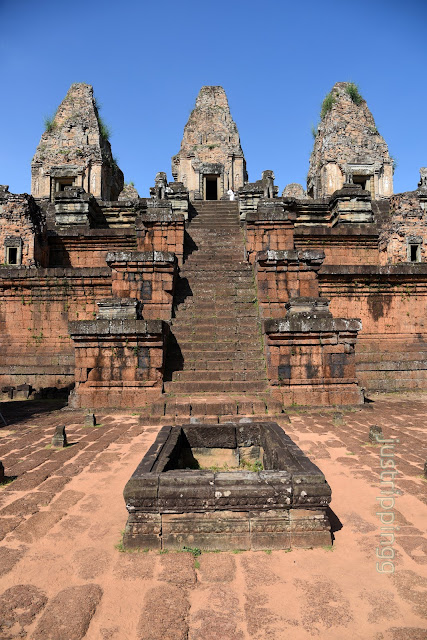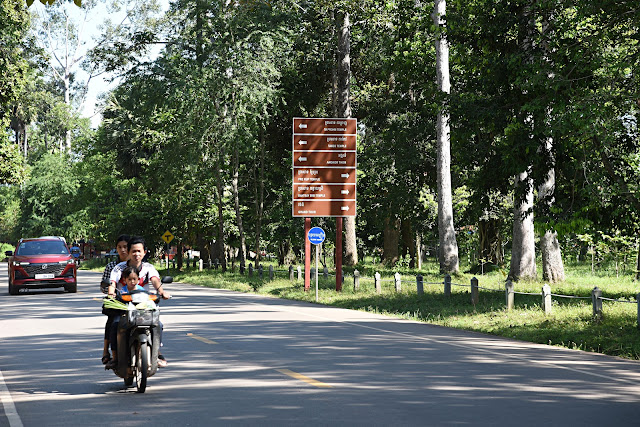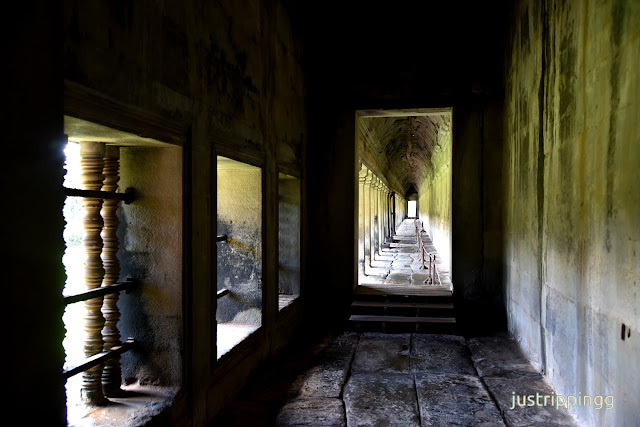Trippingg Abroad
Siem Reap – The Temple Wonderland
Part II
The Groom and His Bride – Mind It
Never before a temple
complex has left you bewildered, awed, flustered, and soaking in sweat all in a
matter of couple of hours. You finally find your way out of the maze, perplexed
and little annoyed as if your brain has been put in a centrifuge and spun. This
is the central temple of Bayon built by Jayavarman VII in his city of Angkor
Thom – an inscription describes Jayavarman as the Groom and the City as his
Bride.
 |
| Bayon Temple, Siem Reap, Cambodia |
 |
| The fantastic fishes and animals - Bas reliefs on Bayon walls |
Yes, Jayavarman VII was on
a construction spree, but here in Bayon it seems even the architects went into
an overdrive and packed everything that they learned from the centuries of
building here in the Khmer Empire. Walking inside the galleries and passages is
not easy. The galleries run on several levels – sometimes you are caught in
total darkness and then you emerge into narrow passages under the sweltering
sun. Some passages have collapsed, while some are being propped up. It is quite
possible that the temple saw construction under successive kings and then
turned into this dense inscrutable place.
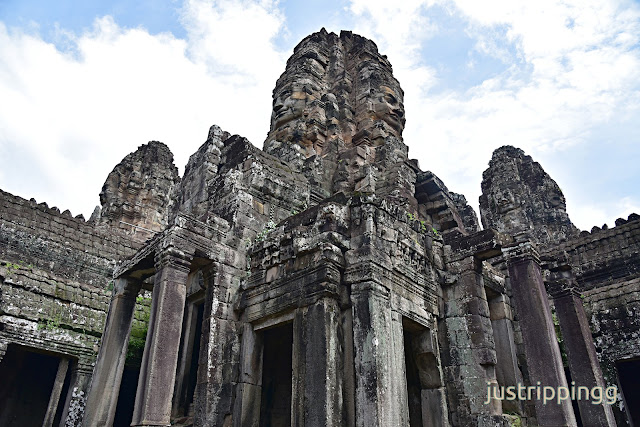 |
| The enigmatic faces on temple shikhars - Bayon Temple, Cambodia |
When you are not watching your step or trying not banging your head on the low overhanging roof, you will look up to see one of the most amazing elements seen anywhere in a temple. Smiling faces look at the surroundings from every tower. Tonle Om provided a glimpse of what was to come. You will stop dumbfounded every now and then. And then you will raise your camera to click – but the tight spaces, alternating dark and fiercely bright spaces will make photography as confounding as trying to make sense of this. This will need several visits over several days including with a guide to decipher a bit of this.
The State Temple of Bayon
or Jayagiri (Victory Mountain or Mountain of Brahma) in City Capital of Angkor
Thom, Buddhist, established by Jayavarman VII, late 12th - early 13th century,
Siem Reap, Cambodia - Conservation being done with support from Japan
The Capital of Koh Ker
In the tradition of earlier
capitals of Mahendraparvat, Hariharalaya (late 8th CE), Yoshodharapura (late
9th CE), Jayavarman IV too would establish his capital rivalling the other
Khmer capital of Angkor. The site was laid out according to Hindu vaastu concept
symbolising the universe. The site was found hidden in the forests between
Dangrek and Kulen mountains, eighty kms NE of Angkor.
 |
| Prasat Krachap, Koh Ker, Cambodia |
The sprawling sacred site
has a number of temples and sanctuaries and will see groundbreaking initiatives
like using monolithic stone blocks, a number of inscriptions in large fonts,
wall paintings, hydraulic structures and some huge images, most of which were
looted and are being gradually repatriated.
 |
| Skand on his Peacock |
 |
| Child Skand with Father Lord Shiv |
Prasat Krachap Temple in
Koh Ker (Lingapura or Chok Gargyar) capital established in 921 by Jayavarman IV
(ruled 928-941), dedicated to Lord Shiv, conservation work by UNESCO, Kulen
District, Preah Vihear Province, Cambodia
Sometimes the Apsara Too
Needs to Let Her Hair Down
It is not easy holding the
demure and mysterious look with all that jewellery and hair-do. Even the
Apsaras need a break. It is said, early morning, when the crowds have left for
their hotels after enjoying the sunrise, Apsaras quickly change into street
clothes and comfortable sneakers and slip out of the gates into the city. Some
go into the woods to have a me-time away from the tourists. They usually go in
ones or twos so as not to attract attention.
 |
| The Apsara of Angkor Wat, Siem Reap, Cambodia |
You thought this was just
another apocryphal story associated with most historical sites. You are here
for the second time. So, you just wait in the shadows as the first golden light
falls on this corner of the central courtyard. And then the sculpture begins to
take form of a life even as you watch spell-bound and dumb-struck. It is only
when the Apsara begins to walk away you remember to raise the camera and click.
A proof is needed otherwise this cynic world would never believe.
As it happened, Angkor Wat,
Cambodia
Koh Ker – Another Surprise
Just like the capitals of
Angkor and Angkor Thom, Koh Ker is sprawling (81 sqkm) and full of surprises.
There are 184 temples here (mapped by Japanese researchers) but since the area
is wooded and mined, only about 25 or so temples are accessible to visitors.
You can see warning signs for mines and signs where areas have been cleared of
mines. Most of the temples you visited were ruined and were undergoing
conservation efforts. Since Koh Ker was capital for a brief period and because
of its distant location, the temples remained Hindu while temples in Angkor and
Angkor Thom would keep changing depending on the state religion.
 |
| Temple complexes in the grounds of Koh Ker, Cambodia |
Temples in Koh Ker
(Lingapura or Chok Gargyar) capital established in 921 by Jayavarman IV (ruled
928-941), dedicated to Lord Shiv, conservation work by UNESCO, Kulen District,
Preah Vihear, Cambodia
Yashovarman’s Capital of
Yashodharapura
On the road to Tonle Om
causeway with the Sagarmanthan depiction, stop on the left. Signs indicate this
is the Bakheng Temple. All you can see is a wooded mountain. The second capital
of Yashodharpura was centred at this Bakheng Mountain, north-west of the first
capital in Rolous. According to a Sanskrit inscription, the mountain was called
Sri Yasodharagiri and in ancient Khmer, it was called Phnom Kandal or Central
Mountain.
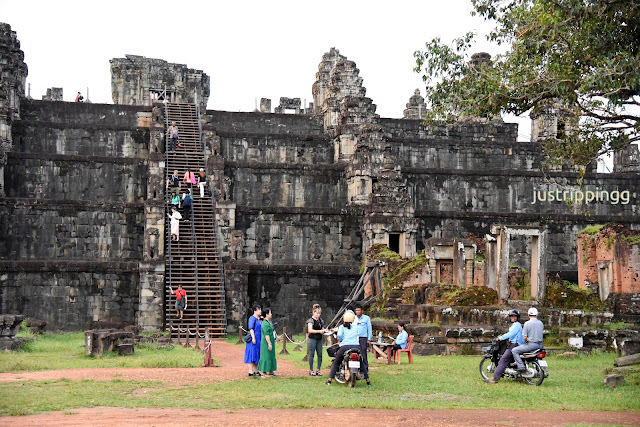 |
| Phnom Bakheng, Siem Reap, Cambodia |
 |
| Nandi looking at his master on the hill |
A fifteen-minute climb
brings you to the top as you enjoy the scenic views of the woods and monuments
on the way with the spires of Angkor Wat rising to the south-east. If Angkor
Wat is the place to view the sun-rise, Bakheng is where the visitors come to
witness the sun-set. These are cloudy days and dusk falls early. You still have
some motivation left to come here after spending a sweltering day getting wowed
by Angkor Wat. The temple has been undergoing restoration for the past twenty
years with the support of World Monuments Fund and US State Department.
Restoration is time-taking since the scale of ruins is as huge as the temples
themselves here in Cambodia.
 |
| On top of Bakheng Temple in SiemReap |
Bakheng again symbolises
Mount Meru, the centre of Hindu Universe. While Bakong sits on flat ground,
Bakheng is built on the mountain - each of the seven tiers of the pyramidal
temple is built on the side of the natural mountain. Wooden steps have been installed
to bring the visitors directly to the top. The top tier has a central shrine
with four on the corners. A total of 108 subsidiary shrines are built on the
seven levels.
Since the evening does not
bring the promise of a sun-set, most visitors have left. You tiptoe around
trying to make sense of the shrines in the dark. Bakong and Bakheng are quite
similar. A lingam is spotted. Away from India, Cambodia seems so close and
similar.
Phnom Bakheng Temple
dedicated to Lord Shiv, Capital of Yashodharapura, established by King
Yashovarman I (889-910), late 9th Century, Siem Reap, Cambodia
The Apsara Wonderland
We have Scorpion Woman of Khajuraho, Madanika of Ramappa Temple, Shalabhanjika of Sanchi, Yakshi of Mathura, Darpan Sundari of Rani ni Vav, Alaskanya of Konark and many more celestial nymphs. Khmer temples have their Apsaras. It is said there are about 1850 Apsaras carved on walls, pillars and ceilings of Angkor Wat.
 |
| The pretty Apsaras on the walls of Angkor Wat, Cambodia |
You have not had time to
study the apsaras but just like India, there would be categorization of these
celestial nymphs. None of them look similar and are adorned with elaborate
head-dresses, hairdos, jewellery and see-through skirts with interesting trains.
They don’t smile but they do have beguiling looks which will be interesting to
decipher. There is only one Apsara who is smiling and showing teeth!
The Authority that is now
looking after maintenance and conservation of the temples, Authority for the
Protection and Safeguarding of Angkor and the Region of Angkor has its acronym
APSARA. While some sculptures are okay there are many that are seeing the
effects of time and nature and are decaying. The restoration work is being done
with support of Germany – GACP (German Apsara Conservation Project).
The Apsaras (also called
Devtas) of Angkot Wat, Siem Reap, Cambodia
The Storytelling Walls of
Angkor Wat
If Indian temples are all about iconography and life-like sculptures, Khmer temples are all about beautiful relief friezes on pediments and walls.
Most motifs in temples here
are based on Mahabharat and Ramayan. In Angkor, along the inner walls of the
outer galleries run magnificent relief work inspired by mythology. Originally,
the reliefs would have colour as some traces of red colour are seen. The work
done during Suryavarman II is the best while some walls were finished after his
death and lack the skill of previous ones.
 |
| Eye-popping relief carvings along the outer hallways - Angkor Wat, Siem Reap, Cambodia |
 |
| The death of Bhishm in Mahabharat - Relief on walls of Angkor Wat Temple |
An iconography-head can
perhaps spend days going over each yard and the three tiers of vertical
reliefs. You are not sure if relief work is done before building the wall or is
done after the stones have been placed. Either way relief sculpture takes as much
skill as the 3D sculptures. Some themes featured here are: Swarg & Narak
(Heaven and Hell), Sagarmanthan, Procession of Suryavarman II, War between
Asurs and Lord Krishna, Battles of Kurukshetra and Lanka.
Signs with identification
of major events and personalities help an ignorant like you and this is what is
special about museums and heritage places abroad – they are both aesthetic and
full of information, qualities that we lack in our country.
Bas Relief Friezes of
Angkor Wat, 600 metres in four galleries, early 12th century, Cambodia
Beng Mealea – Heap of
Stones
Beng Mealea is simply a
glorious heap of stones in stately ruin. All this is quite unbelievable. When
you are still trying to figure out how he was able to build Angkor Wat in
thirty years or so considering the scale of construction, here is Suryavarman replicating
the feat in Beng Mealea. The temple is as large as Angkor Wat with a similar
plan.
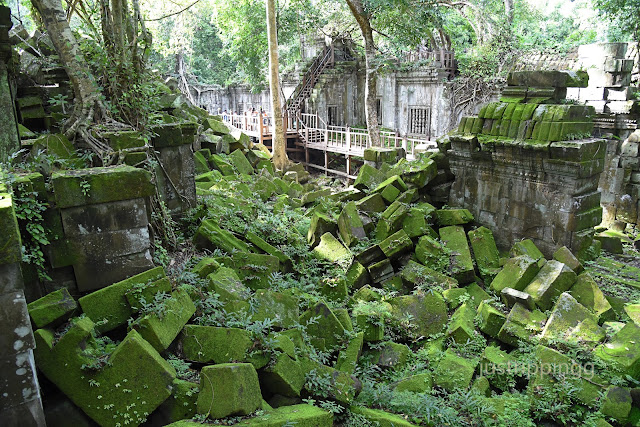 |
| The ruined wonderland - Beng Melea, Cambodia |
And if Angkor Wat is
largely intact, what calamity befell here that nothing substantial seems to
have survived. Was it a construction deficiency? Or maybe the temple fell off
the radar and the worship and royal patronage shifted to Angkor Wat? Why would Suryavarman
build as big a temple? The Great Kings of Khmer Empire did have an incurable
itch to binge build. Was this temple a prototype to later construct Angkor Wat?
He would also build Phimai and Phanom Rung temples, both in Thailand.
 |
| The richly carved pediment of Beng Melea, Cambodia |
Conservation, whenever it
starts, is going to be a monumental task. For now, the archaeologists are just
trying to find some answers buried under the heaps of brick-like cut sandstone
heaps. The jungle mist hangs heavy over Beng Mealea.
Beng Mealea – Temple of
Lotus Pond, Hindu-Buddhist, 12th Century, built by Suryavarman II (r 1113-1150)
or Paramavishnuloka, about 60km NE of Angkor Wat, Siem Reap Province, Cambodia
Charge of the Elephant
Brigade
Angkor Thom is full of
wonders and they never stop coming. Next to the entrance of Baphuon Temple is
the Elephant Terrace that was part of the Palace of Phimeanakas. The Terrace
looked out into the Central Square. The King would sit here inspecting his armies
as they returned victorious. This was also a public audience hall. In the
middle, the terrace has Garuds and Lions while the outer flanks has elephants.
 |
| The Elephant Terrace in Angkor Thom, Siem Reap, Cambodia |
Bayon has the enigmatic
Smiling Faces, Baphuon has some interesting reliefs, this terrace shows a
parade of elephants. This needs to be figured out if the elephants were carved
after placing the stones on the platform or were the stones carved first and then
placed to form the platform of the terrace. Wonders in Angkor Thom will keep
coming.
Extensive restoration work
is going on. It all looks scientific and aesthetic. A shed has been installed
over the work area to protect the workers from the heat. From what you can see,
currently the Nag balustrade is getting new pieces.
Eastern Flank of Elephant
Terrace, built during the times of Jayavarman VII, The Great (1122-1218),
Angkor Thom, Cambodia
Jayavarman’s Capital of
Hariharalaya
Before entering the last
capital of Angkor Thom, let us go back in time and visit the first capital. A
thirty-minute drive to the south-east of Angkor Wat brings you to Rolous where
the first capital of Hariharalaya was established around the temple of Bakong,
just north of Tonle Sap Lake.
Just like Angkor Wat, the
flagship temples were depicted as Mount Meru. The inspiration might have come
from India but here the Cambodians let their creativity soar. While Angkor Wat
and temples in India have spires or shikhars denoting peaks, here multi-tiered
pyramidal architecture is used in the first two capitals.
 |
| Bakong Temple - Siem Reap, Cambodia |
The temple is built in a
beautiful setting that reminds you of Sukhothai in Thailand. Dusk is
approaching and you have the temple to yourself. Chanting from the active
Buddhist monastery on the grounds fill the rapidly darkening skies. On top of
the five-tiered pyramid is the central shrine that reminds you of Angkor Wat.
As you look around from the top, the central temple is surrounded by beautiful
subsidiary brick temples. Some are in excellent repair while others are
undergoing restoration.
 |
| Bakong Temple - Siem Reap, Cambodia |
These are beautiful
moments. You wish you had time to explore the grounds and the other two temples
here in Rulous. But that is what you seem to be running out of here in
Cambodia. So much to see and so little time.
Bakong Temple dedicated to
Shiv, Pre-Angkor, late 8th Century, Hariharalaya capital established by
Jayavarman II (810-850), Siem Reap, Cambodia
Temple Run Continues
A successor to Bakheng
Temple, Pre Rup is again monumental and pyramidal. Unlike Bakheng it is built
on plain ground and like Bakheng it has several towers or shrines built on the
different tiers. While Bakheng is quite ruined, Pre Rup is in better condition
with surviving Gopuras on the four sides.
 |
| Pre Rup Temple, Cambodia |
It is still morning but the sun is already burning hot. There is a long list of temples to visit on the last day here in Siem Reap. You will give climbing to the top a miss. Back to tuk-tuk and to the next temple.
Timeline of Temples so far
Bakong, Lord Shiv, King Jayavarman II (810-850)
Phnom Bakheng, Lord Shiv, King Yashovarman I (889-910)
Pre Rup, Lord Shiv, King
Rajendravarman II (944-968)
Baphuon, Lord Shiv, King
Suryavarman I (1010-1050)
Angkor Wat, Lord Vishnu,
King Suryavarman II (1113-1150)
Bayon Temple, Lord Brahm or
Buddhist?, King Jayavarman VII (1182-1218)
Pre Rup Temple dedicated to
Lord Shiv, established in 962 CE by King Rajendravarman II (944-968), Angkor
Period of Khmer Empire or Kambuja or Kambujades, Angkor Arch Park, Cambodia
earlier known as Kampuchea derived from Kambuja
People of Angkor Wat
If the people of Thailand
are nice, Cambodians are even nicer. You would request them to pose and they
would do smilingly.
You love this ritual in SE
Asia where the nice folks come dressed in their traditional best to their
temples.
Two Days at Angkor Wat, Cambodia
Related Posts on this Blog

